- Have any questions?
- +86 18868944843
- roy@nbthe.com
Tennis racket grip
Tennis racket grip
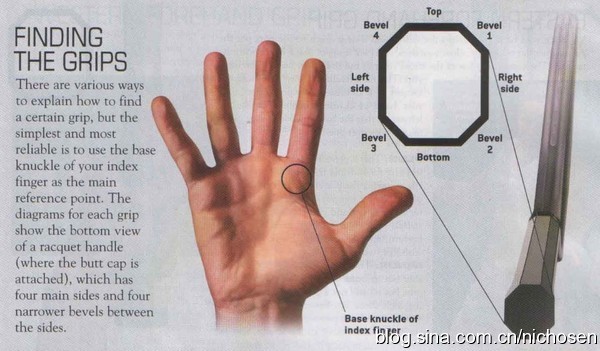
Tennis racket grip (seven basic tennis racket grips) include: continental, east style, half-west mode, west mode, super-west mode, east mode backhand, two-handed grip; each has different advantages and disadvantages. Solve doubts for you completely.
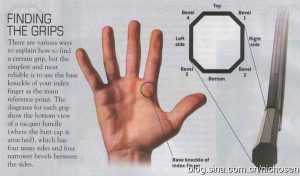
1. Continental grip:
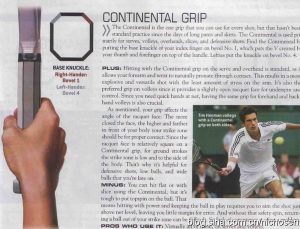
The right index finger joint is on the upper right side, while the tiger’s mouth is on the upper side.
Right-handed continental grip: the knuckles of the index finger are in contact with the facet on the upper right. Naturally, your tiger’s mouth is above the handle.
Left-handed continental grip: the knuckles of the index finger and the facet contact on the right
The hitting position of the continental grip will be closer and lower to the side of your body.
Strengths: The continental grip is suitable for serving, netting, cutting, and defensive play. Especially in front of the net interception, because there is no need to switch between the front and back, so you can react quickly. In addition, because this grip makes the face relatively open (the open face means that your face is parallel to the net, the closed face means that your face is perpendicular to the net, so it is processed off the ground. A low ball and a flat shot are more advantageous.
Shortcomings: Because it is difficult to play a good topspin when a player wants to play a threatening ball or save the ball, it needs the ball to be more accurate than other grips, so the stable and accurate hitting is the player’s face. The right puzzle.
2. East way grip:
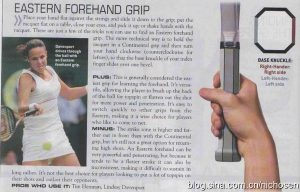
The right hand is on the right side of the index finger joint, while the tiger’s mouth is on the right side.
Right-handed grip: When you use the continental grip, turn your wrist clockwise until your index finger knuckles are in contact with the right side of the handle and the handle on the right.
Left-handed mode grip: When you use the continental grip, turn your wrist counterclockwise until your index finger knuckles are in contact with the left side of the handle by the facet on the upper left side of the handle.
Strengths: This grip is recognized as the easiest to learn, and allows the player to hit the spin and the aggressive flat shot. In the end, the player can quickly change the grip, so the tennis player usually chooses this grip.
Shortcomings: Although the hitting area is higher from the ground and at the front of the player’s position, it is still more difficult to deal with the higher return from the ground. In addition, it is still at a disadvantage when it is struggling with the bottom line.
3. Semi-Western grip method:
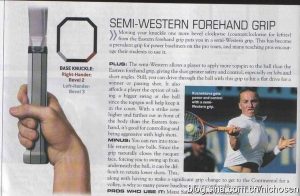
The right hand is below the right side of the index finger joint, while the tiger’s mouth is on the right side.
Right-hand half-West mode grip: Use the East method to hold the clock clockwise until the index finger knuckles are in contact with the facet at the lower right of the racket grip.
Left-handed and half-Western grip: Use the East grip to rotate the wrist counterclockwise until the index finger knuckles are in contact with the facet at the lower left of the racket grip.
Strengths: This is the grip method used by the bottom line players. Because this grip can be used to create a stable topspin, allowing the golfer to better control the ball’s landing point. It works well for dealing with balls that are higher from the ground because the hitting area is higher from the ground and more forward than the body.
Shortcomings: Passive to the low ball, because the face is parallel to the ground, so the golfer must move the racket to the ball to catch the ball. In addition, the netball is also a dead hole, because it is not convenient to switch to the continental grip.
4. Western-style grip:
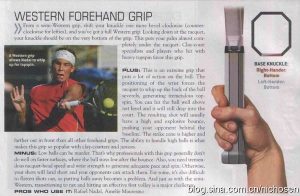
The right index finger joint is on the lower side and the tiger’s mouth is on the lower right side.
Right-handed-style grip: Turn your wrist clockwise from the semi-Western grip until the wrist is below the handle, which means your palm is almost below the handle.
Left-handed West grip: Turn the wrist counterclockwise from the semi-Western grip until the wrist is below the handle
Strengths: This grip requires the player to shoot up and forward from the bottom of the ball, so that a high and powerful topspin can be played, leaving the opponent outside the bottom line. It is the preferred grip for clay players. In addition, beginners can also choose the grip method. The hitting area is higher from the ground and farther from the body. So it is most effective for handling high balls.
Shortcomings: It is very difficult to handle low balls. In addition, it does not apply to hard ground and grass fields where the ball speed is faster, because it requires the golfer to use more wrist force and faster swing speed to play an effective ball. The same, it does not apply to the front of the network interception.
5. East way backhand grip:
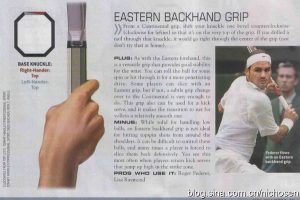
The right index finger joint is on the upper side, and the tiger’s mouth is on the upper left side.
Right-handed approach with one hand: use the continental grip to turn the wrist counterclockwise until the index finger knuckles are above the handle
Left-handed approach with one hand: use the continental grip to turn the wrist clockwise until the index finger knuckles are above the handle
Strengths: Your wrists will remain stable when you hit the ball. In addition, the golfer can play the ball with the top or the offensive, or the backhand. Finally, this grip helps the player to spin the ball.
Shortcomings: Not very effective for handling backhand highballs. The usual solution is to use defensive clipping.
6. Super West mode grip:
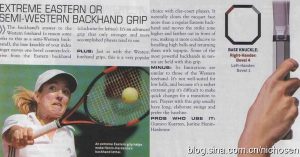
The right index finger joint is on the lower left side, while the tiger’s mouth is on the lower side.
Right-handed, non-complete Western-style one-handed backhand: Use the East one-handed backhand to turn the wrist counterclockwise until the index finger knuckles and the left upper edge of the handle are in contact with each other.
Left-handed, non-complete western-style one-handed backhand: Turn the wrist clockwise with one-handed backhand until the index finger knuckles and the upper right side of the handle are in contact with the facet
Strengths: The most effective way to deal with high balls is to play the most powerful topspin. Experienced golfers use this grip, and golfers who are good at playing clay courts also use this grip. Its hitting area is so high that it is the highest from the ground and farthest from the body.
Shortcomings: Like the Western way forehand, it is the least in terms of handling low balls. Netball is another weakness.
7. Two-handed grip:
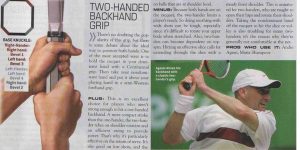
Put the hand that you force with the Continental grip and the other assisted hand with the non-complete western approach.
This two-handed grip is the most common two-handed grip.
Strengths: It is not the habit of a golfer to use one hand to hit the ball. This is the best choice. Because it is the rotation of the shoulder and the swing of the two hands, the action of returning the ball is more consistent and smooth than the one-handed backhand, so it is ideal to deal with the returning serve. In addition, it is also very effective in returning to the low ball. Finally, thanks to the help of the assisting hand, the golfer can handle the ball with the same height as the shoulder.
Shortcomings: Because both hands are placed on the handle, it limits the coverage of the player. The return to the far point can only be heartless and powerless. In addition, the player’s backhand style is also a top-spinning ball. Due to the support of the assisting hand, the player is more jealous of the ball-cutting and the net-front ball.
